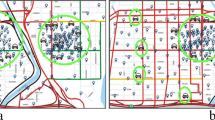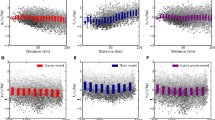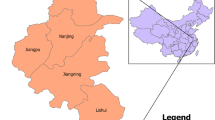Abstract
This paper investigates human mobility patterns in an urban taxi transportation system. This work focuses on predicting humanmobility fromdiscovering patterns of in the number of passenger pick-ups quantity (PUQ) from urban hotspots. This paper proposes an improved ARIMA based prediction method to forecast the spatial-temporal variation of passengers in a hotspot. Evaluation with a large-scale realworld data set of 4 000 taxis’ GPS traces over one year shows a prediction error of only 5.8%. We also explore the application of the prediction approach to help drivers find their next passengers. The simulation results using historical real-world data demonstrate that, with our guidance, drivers can reduce the time taken and distance travelled, to find their next passenger, by 37.1% and 6.4%, respectively.
Similar content being viewed by others
References
Zhang D, Guo B, Yu Z. The emergence of social and community intelligence. Computer, 2011, 44(7): 21–28
Ratti C, Pulselli R M, Williams S, Frenchman D. Mobile Landscapes: using location data from cell phones for urban analysis. Environment and Planning B: Planning and Design, 2006, 33(5): 727–748
Zhu H, Zhu Y, Li M, Ni L. SEER: metropolitan-scale traffic perception based on lossy sensory data. In: Proceedings of the 28th Conference on Computer Communications. 2009, 217–225
Calabrese F, Pereira F C, Lorenzo G D, Liu L, Ratti C. The geography of taste: analyzing cell-phone mobility and social. In: Proceedings of the 8th International Conference on Pervasive Computing. 2010, 22–37
Girardin F, Blat J, Calabrese F, Fiore F, Ratti C. Digital Footprinting: uncovering tourists with user-generated content. IEEE Pervasive Computing, 2008, 7(4): 36–43
Ahas R, Aasa A, Silm S, Tiru M. Mobile positioning data in tourism studies and monitoring: case study in Tartu, Estonia. In: Proceedings of International Conference on Information and Communication Technologies in Tourism. 2007, 119–128
Girardin F, Vaccari A, Gerber A, Biderman A, Ratti C. Quantifying urban attractiveness from the distribution and density of digital footprints. International Journal of Spatial Data Infrastructures Research, 2009, 4: 175–200
Gonz’alez M, Hidalgo C, Barabasi A. Understanding individual human mobility patterns. Nature, 2008, 453: 779–782
McNamara L, Mascolo C, Capra L. Media sharing based on collocation prediction in urban transport. In: Proceedings of the 14th ACM Annual International Conference on Mobile Computing and Networking. 2008, 58–69
Froehlich J, Neumann J, Oliver N. Sensing and predicting the pulse of the city through shared bicycling. In: Proceedings of the 21st International Joint Conference on Artificial Intelligence. 2009, 1420–1426
Kaltenbrunner A, Meza R, Grivolla J, Codina J, Banchs R. Urban cycles and mobility patterns: exploring and predicting trends in a bicyclebased public transport system. Pervasive and Mobile Computing, 2010, 6(4): 455–466
Ziebart B, Maas A, Dey A, Bagnell J. Navigate like a cabbie: probabilistic reasoning from observed context-aware behavior. In: Proceedings of the 10th ACM International Conference on Ubiquitous Computing. 2008, 322–331
Yuan J, Zheng Y, Zhang C, Xie W, Xie X, Sun G, Huang Y. T-Drive: driving directions based on taxi trajectories. In: Proceedings of the 18th ACM International Conference on Advances in Geographic Information Systems. 2010, 99–108
Liu L, Andris C, Ratti C. Uncovering cabdrivers’ behavior patterns from their digital traces. Computers, Environment and Urban Systems, 2010, 34(6): 541–548
Zheng Y, Liu Y, Yuan J, Xie X. Urban computing with taxicabs. In: Proceedings of the 13th ACM International Conference on Ubiquitous Computing. 2011, 89–98
Zhang D, Li N, Zhou Z, Chen C, Sun L, Li S. iBAT: detecting anomalous taxi trajectories from GPS traces. In: Proceedings of the 13th ACM International Conference on Ubiquitous Computing. 2011, 99–108
Phithakkitnukoon S, Veloso M, Bento C, Biderman A, Ratti C. Taxi-Aware Map: identifying and predicting vacant taxis in the city. In: Proceedings of the 1st International Joint Conference on Ambient Intelligence. 2010, 86–95
Chang H W, Tai Y C, Hsu Y J. Context-aware taxi demand hotspots prediction. International Journal of Business Intelligence and Data Mining, 2010, 5(1): 3–18
Ge Y, Xiong H, Tuzhilin A, Xiao K, Gruteser M. An energy-efficient mobile recommender system. In: Proceedings of the 16th ACM Inter national Conference on Knowledge Discovery and Data mining. 2010, 899–908
Yuan J, Zheng Y, Zhang L, Xie X, Sun G. Where to find my next passenger? In: Proceedings of the 13th ACM International Conference on Ubiquitous Computing. 2011, 109–118
Qi G, Li X, Li S, Pan G, Zhang D. Measuring social functions of city regions from large-scale taxi behaviors. In: Proceedings of the 9th IEEE International Conference on Pervasive Computing and Communications, WiP. 2011, 384–388
Beucher S, Lantuejoul C. Use of watersheds in contour detection. In: Proceedings of the International Workshop on Image Processing: Realtime Edge and Motion Detection/Estimation. 1979
Box G, Jenkins G, Reinsel G. Time Series Analysis: Forecasting and Control. 4th ed. Hoboken: John Wiley & Sons, 2008
Makridakis S, Hibon M. The M3-Competition: results, conclusions and implications. International Journal of Forecasting, 2000, 16(4): 451–476
Cooper R. Introduction to Queueing Theory. New York: Macmillan, 1972
Author information
Authors and Affiliations
Corresponding author
Additional information
Xiaolong Li is a Masters student of the Department of Computer Science at Zhejiang University. He received his BSc in Computer Science from the Northwestern Polytechnical University, Xi’an, China. His research interests include pervasive computing and data mining.
Gang Pan received his BSc and PhD in Computer Science in 1998 and 2004, respectively, from Zhejiang University, Hangzhou, China. He has been with the College of Computer Science and Technology, Zhejiang University, since 2004, where he is currently an associate professor of computer science. His research interests include pervasive computing, computer vision, and pattern recognition. He serves as secretary of the CCF Technical Committee on Pervasive Computing. He has served as a program committee member for more than ten prestigious international conferences, such as ICCV, CVPR, and UIC, and as a reviewer for several prestigious journals, such as IEEE TPAMI, TIP, TSMC, TVCG, and PUC.
Zhaohui Wu is a professor in the Department of Computer Science at Zhejiang University, China. His research interests include distributed artificial intelligence, semantic grid, and ubiquitous computing.Wu has a PhD in Computer Science from Zhejiang University. He is a standing council member of the China Computer Federation.
Guande Qi is a PhD student of the Department of Computer Science at Zhejiang University. He received his BSc in Life Sceince from Zhejaing University. His research interests include machine learning and data mining.
Shijian Li received his PhD from the College of Computer Science and Technology, Zhejiang University, in 2006. He worked in the Institute Telecom SudParis, France, as a visiting scholar in 2010. His research interests include sensor networks, ubiquitous computing, and social computing. He has published over 40 papers in the above domains. He works as an editor of the International Journal of Distributed Sensor Networks, and as reviewer or PC member of more than 10 conferences.
Daqing Zhang is a professor at the Institute Telecom SudParis, France. He obtained his PhD from the University of Rome “La Sapienza” and the University of L’Aquila, Italy in 1996. His research interests include pervasive and human-centric sensing, context-aware systems, social and community intelligence, mobile social networks, and pervasive healthcare. He is a member of IEEE and ACM. Contact him at daqing.zhang@itsudparis. eu.
Wangsheng Zhang is a PhD candidate in the Department of Computer Science at Zhejiang University. He received his MSc in Industrial Engineering from Tsinghua University. His research interests are in social networks and individual mobility patterns.
Zonghui Wang is an assistant professor in the College of Computer Science and Technology at Zhejiang University, China. He received his PhD from the College of Computer Science and Engineering at Zhejiang University in 2007. His research interests focus on intelligent transportation, distributed simulation, and computer architectures.
Rights and permissions
About this article
Cite this article
Li, X., Pan, G., Wu, Z. et al. Prediction of urban human mobility using large-scale taxi traces and its applications. Front. Comput. Sci. 6, 111–121 (2012). https://doi.org/10.1007/s11704-011-1192-6
Received:
Accepted:
Published:
Issue Date:
DOI: https://doi.org/10.1007/s11704-011-1192-6




